9.2 Types of Writing Assignments
Stevy Scarbrough
Learning Objectives
Upon completion of this reading, you will be able to:
- Identify common types of academic assignments used in university settings
- Differentiate between the structure, purpose, and audience of various assignment types
- Recognize the specific skills required to complete each type of assignment effectively
- Understand the expectations and assessment criteria commonly associated with different assignment formats
- Apply appropriate strategies for planning, researching, and structuring different types of academic tasks
As discussed in the previous section, assignments are a common method of assessment in college You may encounter many assignments over your years of study, yet some will look quite different from others. By recognizing different types of assignments and understanding the purpose of the task, you can direct your writing skills effectively to meet task requirements. This section draws on the skills from the previous section, and extends the discussion, showing you where to aim with different types of assignments.
The section begins by exploring the popular essay assignment, with its two common categories, analytical and argumentative essays. It then examines assignments requiring case study responses, as often encountered in fields such as health or business. This is followed by a discussion of assignments seeking a report (such as a scientific report) and reflective writing assignments, common in nursing, education and human services. The chapter concludes with an examination of annotated bibliographies and literature reviews. The chapter also has a selection of templates and examples throughout to enhance your understanding and improve the efficacy of your assignment writing skills.

Different Types of Written Assignments
Essay
At university, an essay is a common form of assessment. In the previous section we discussed what was meant by showing academic writing in your assignments. It is important that you consider these aspects of structure, tone and language when writing an essay.
Components of an essay
Essays should use formal but reader friendly language and have a clear and logical structure. They must include research from credible academic sources such as peer reviewed journal articles and textbooks. This research should be referenced throughout your essay to support your ideas.
If you have never written an essay before, you may feel unsure about how to start. Breaking your essay into sections and allocating words accordingly will make this process more manageable and will make planning the overall essay structure much easier.
- An essay requires an introduction, body paragraphs and a conclusion.
- Generally, an introduction and conclusion are approximately 10% each of the total word count.
- The remaining words can then be divided into sections and a paragraph allowed for each area of content you need to cover.
- Use your task and criteria sheet to decide what content needs to be in your plan
An effective essay introduction needs to inform your reader by doing four basic things:
- Engage their interest and provide a brief background of the topic.
- Provide a thesis statement. This is the position or argument you will adopt. (Note a thesis statement is not always required. Check with your tutor).
- Outline the structure of the essay.
- Indicate any parameters or scope that will/will not be covered.
The body paragraph needs to state the topic sentence or main point of the paragraph. If you have a thesis statement, the topic sentence should relate to this. Expand this main idea, define any terminology and explain concepts in more depth. This information should be paraphrased and referenced from credible sources according to the appropriate referencing style of your course. Demonstrate critical thinking by showing the relationship of the point you are making and the evidence you have included. This is where you introduce your “student voice”. Ask yourself “So what?” to add a discussion or interpretation of the how evidence you have included in your paragraph is relevant to your topic. Conclude your idea and link to your next point.
An effective essay conclusion needs to summarize or state the main points covered, using past tense. Provide an overall conclusion that relates to the thesis statement or position you raised in your introduction. Not add any new information.
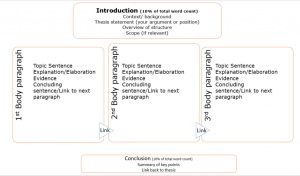
Common types of essays
You may be required to write different types of essays, depending on your study area and topic. Two of the most commonly used essays are analytical and argumentative. The task analysis process discussed in the previous section will help you determine the type of essay required. For example, if your assignment question uses task words such as analyze, examine, discuss, determine or explore, you would be writing an analytical essay. If your assignment question has task words such as argue, evaluate, justify or assess, you would be writing an argumentative essay. Despite the type of essay, your ability to analyze and think critically is important and common across genres.
Analytical essays
These essays usually provide some background description of the relevant theory, situation, problem, case, image, etc. that is your topic. Being analytical requires you to look carefully at various components or sections of your topic in a methodical and logical way to create understanding.

The purpose of the analytical essay is to demonstrate your ability to examine the topic thoroughly. This requires you to go deeper than description by considering different sides of the situation, comparing and contrasting a variety of theories and the positives and negatives of the topic. Although in an analytical essay your position on the topic may be clear, it is not necessarily a requirement that you explicitly identify this with a thesis statement, as is the case with an argumentative essay. If you are unsure whether you are required to take a position, and provide a thesis statement, it is best to check with your tutor.
Argumentative essays
These essays require you to take a position on the assignment topic. This is expressed through your thesis statement in your introduction. You must then present and develop your arguments throughout the body of your assignment using logically structured paragraphs. Each of these paragraphs needs a topic sentence that relates to the thesis statement. In an argumentative essay, you must reach a conclusion based on the evidence you have presented.
In order to create a good and effective argument, you need to be able to:
- Read critically to find evidence
- Plan your argument
- Think and write critically throughout your paper to enhance your argument

As can be seen from the figure above, including evidence is a key element of a good argument. While this may seem like a straightforward task, it can be difficult to think of wording to express your argument. The table below provides examples of how you can illustrate your argument in academic writing (see Table 9.5).
| Introducing your argument | • This paper will argue/claim that… • …is an important factor/concept/idea/ to consider because… • … will be argued/outlined in this paper. |
| Introducing evidence for your argument | • Smith (2014) outlines that…. • This evidence demonstrates that… • According to Smith (2014)… • For example, evidence/research provided by Smith (2014) indicates that… |
| Giving the reason why your point/evidence is important | • Therefore this indicates… • This evidence clearly demonstrates…. • This is important/significant because… • This data highlights… |
| Concluding a point | • Overall, it is clear that… • Therefore, … are reasons which should be considered because… • Consequently, this leads to…. • The research presented therefore indicates… |
Case Study Responses
Case studies are a common form of assignment in many study areas and students can underperform in this genre for a number of key reasons.
Students typically lose marks for not:
- Relating their answer sufficiently to the case details
- Applying critical thinking
- Writing with clear structure
- Using appropriate or sufficient sources
- Using accurate referencing
When structuring your response to a case study, remember to refer to the case. Structure your paragraphs similarly to an essay paragraph structure but include examples and data from the case as additional evidence to support your points (see Figure 20.5). The colors in the sample paragraph below show the function of each component.

Case Study Example
1) The Nursing and Midwifery Board of Australia (NMBA) Code of Conduct and Nursing Standards (2018) play a crucial role in determining the scope of practice for nurses and midwives. 2) A key component discussed in the code is the provision of person-centred care and the formation of therapeutic relationships between nurses and patients (NMBA, 2018). This ensures patient safety and promotes health and wellbeing (NMBA, 2018). The standards also discuss the importance of partnership and shared decision-making in the delivery of care (NMBA, 2018, 4). Boyd and Dare (2014) argue that good communication skills are vital for building therapeutic relationships and trust between patients and care givers. 3) This will help ensure the patient is treated with dignity and respect and improve their overall hospital experience. 4) In the case, the therapeutic relationship with the client has been compromised in several ways. Firstly, the nurse did not conform adequately to the guidelines for seeking informed consent before performing the examination as outlined in principle 2.3 (NMBA, 2018). 3) Although she explained the procedure, she failed to give the patient appropriate choices regarding her health care.
1) Topic sentence
2) Explanations using paraphrased evidence including in-text references
3) Critical thinking (asks the so what? question to demonstrate your student voice)
4) Relating the theory back to the specifics of the case. The case becomes a source of examples as extra evidence to support the points you are making.
Report
Reports are a common form of assessment in college and are also used widely in many professions. It is a common form of writing in business, government, scientific, and technical occupations.
Reports can take many different structures. A report is normally written to present information in a structured manner, which may include explaining laboratory experiments, technical information, or a business case. Reports may be written for different audiences including clients, your manager, technical staff, or senior leadership within an organization. The structure of reports can vary, and it is important to consider what format is required. The choice of structure will depend upon professional requirements and the ultimate aims of the report. Consider some of the options in the table below (see Table 9.6).
| Executive or Business Reports | Overall purpose is to convey structured information for business decision making. |
| Short form or Summary Reports | Are abbreviated report structures designed to convey information in a focused short form manner. |
| Scientific Reports | Are used for scientific documentation purposes and may detail the results of research or describe an experiment or a research problem. |
| Technical Reports | Are used to communicate technical information for decision making, this may include discussing technical problems and solutions. |
| Evaluation Reports | Present the results of or a proposal for an evaluation or assessment of a policy, program, process or service. |
Reflective Writing
Reflective writing is a popular method of assessment in college. It is used to help you explore feelings, experiences, opinions, events or new information to gain a clearer and deeper understanding of your learning. A reflective writing task requires more than a description or summary. It requires you to analyze a situation, problem or experience, consider what you may have learned and evaluate how this may impact your thinking and actions in the future. This requires critical thinking, analysis, and usually the application of good quality research, to demonstrate your understanding or learning from a situation. Essentially, reflective practice is the process of looking back on past experiences and engaging with them in a thoughtful way and drawing conclusions to inform future experiences. The reflection skills you develop in college will be vital in the workplace to assist you to use feedback for growth and continuous improvement. There are numerous models of reflective writing and you should refer to your subject guidelines for your expected format. If there is no specific framework, a simple model to help frame your thinking is What? So what? Now what? (Rolfe et al., 2001).
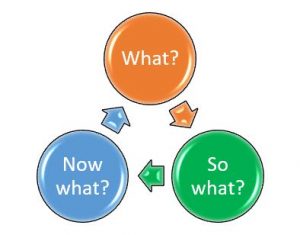
| What? | Describe the experience – who, what, why, when, where? |
| So what? | What have you learnt from this? Why does it matter? What has been the impact on you? In what way? Why? You can include connections to coursework, current events, past experiences. |
| Now what? | What are you going to do as a result of your experience? How will you apply what you have learnt in the future? Are there critical questions to further pursue? Make an action plan of what you will do next. |
The Gibbs’ Reflective Cycle
The Gibbs’ Cycle of reflection encourages you to consider your feelings as part of the reflective process. There are six specific steps to work through. Following this model carefully and being clear of the requirements of each stage, will help you focus your thinking and reflect more deeply. This model is popular in Health.
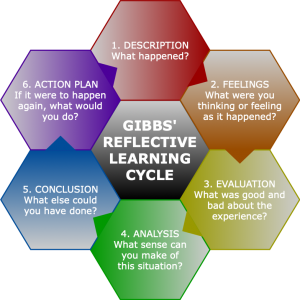
The 4 R’s of reflective thinking
The 4R’s Framework provides an easy-to-remember reflection model that leads students toward understanding and applying their experiential learning (Ryan & Ryan, 2013). Experiential learning includes any ‘real-world’ activities including practice led activities, placements and internships. It provides stepping stones for the process by starting with simpler forms of observation and feeling (Reporting and Responding) and then moving to apply these observations and feelings to existing structures of knowledge or understanding (Relating). The next two stages encourage the learner first to apply intellectual and theoretical conceptualizations to their experience (Reasoning) and finally to synthesize the learning into a plan of action or a new mode of thinking (Restructuring).
Like the other reflection models, this approach breaks down the learning process into several stages that help students build toward a new or larger understanding of the experience and the course material. These steps help learners make the best use of their experiences by emphasizing the process over the product and the growth in understanding over the accumulation of facts. The use of reflective practice to heighten this learning, is common in Creative Arts, Health and Education.
Annotated Bibliography
What is it?
An annotated bibliography is an alphabetical list of appropriate sources (books, journals or websites) on a topic, accompanied by a brief summary, evaluation and sometimes an explanation or reflection on their usefulness or relevance to your topic. Its purpose is to teach you to research carefully, evaluate sources and systematically organize your notes. An annotated bibliography may be one part of a larger assessment item or a stand-alone assessment piece. Check your task guidelines for the number of sources you are required to annotate and the word limit for each entry.
How do I know what to include?
When choosing sources for your annotated bibliography it is important to determine:
- The topic you are investigating and if there is a specific question to answer
- The type of sources on which you need to focus
- Whether they are reputable and of high quality
What do I say?
Important considerations include:
- Is the work current?
- Is the work relevant to your topic?
- Is the author credible/reliable?
- Is there any author bias?
- The strength and limitations (this may include an evaluation of research methodology).
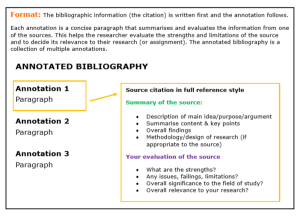
Literature Reviews
It is easy to get confused by the terminology used for literature reviews. Some tasks may be described as a systematic literature review when actually the requirement is simpler; to review the literature on the topic but do it in a systematic way. There is a distinct difference (see Table 9.8). As an undergraduate student, it is unlikely you would be expected to complete a systematic literature review as this is a complex and more advanced research task. It is important to check with your instructor if you are unsure of the requirements.
| A literature review | A systematic literature review |
| A review which analyses and synthesizes the literature on your research topic in a systemic (clear and logical) way. It may be organized: • Conceptually • Chronologically • Methodologically |
A much larger and more complicated research project which follows a clearly defined research protocol or process to remove any reviewer bias. Each step in the search process is documented to ensure it is able to be replicated, repeated or updated. |
Generally, you are required to establish the main ideas that have been written on your chosen topic. You may also be expected to identify gaps in the research. A literature review does not summarize and evaluate each resource you find (this is what you would do in an annotated bibliography). You are expected to analyze and synthesize or organize common ideas from multiple texts into key themes which are relevant to your topic (see Figure 9.11).
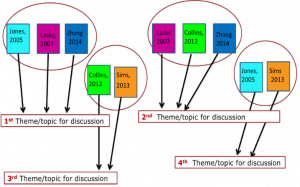
Use a table or a spreadsheet to organize the information you find. Record the full reference details of the sources as this will save you time later when compiling your reference list (see Figure 9.12).
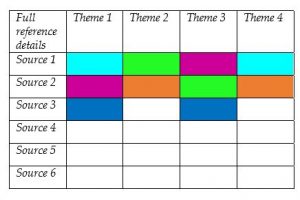
Getting Help with Writing
Most colleges provide resources that can help you from the early stages of an assignment through to the completion of an essay. Your first resource may be a writing class. Most colleges also have a tutoring service that focuses primarily on student writing. Look up and visit your tutoring and/or writing center early in the term to learn what service is offered. Specifically, check the following:
- Do you have to register in advance for help? If so, is there a registration deadline?
- Are appointments required or encouraged, or can you just drop in?
- Are regular standing appointments with the same tutor encouraged?
- Are a limited number of sessions allowed per term?
- Are small group workshops offered in addition to individual appointments?
- Are specialists available for help with students who have learned English as a second language?
Three points about writing tutors are crucial:
- Writing tutors are there for all student writers—not just for weak or inexperienced writers. Writing in college is supposed to be a challenge. Some students make writing even harder by thinking that good writers work in isolation. But writing is a social act. A good paper should engage others.
- Tutors are not there for you to “correct” sentence-level problems or polish your finished draft. They will help you identify and understand sentence-level problems so that you can achieve greater control over your writing. But their more important goals often are to address larger concerns like the paper’s organization, the fullness of its development, and the clarity of its argument. So don’t make your first appointment the day before a paper is due, because you may need more time to revise after discussing the paper with a tutor.
- Tutors cannot help you if you do not do your part. Tutors respond only to what you say and write; they cannot enable you to magically jump past the thinking an assignment requires. So do some thinking about the assignment before your meeting and be sure to bring relevant materials with you. For example, bring the paper assignment. You might also bring the course syllabus and perhaps even the required textbook. Most importantly, bring any writing you’ve done in response to the assignment (an outline, a thesis statement, a draft, an introductory paragraph). If you want to get help from a tutor, you need to give the tutor something to work with.
Teaching assistants and instructors. In a large class, you may have both a course instructor and a teaching assistant (TA). Seek help from either or both as you draft your essay. Some instructors offer only limited help. They may not, for example, have time to respond to a complete draft of your essay. But even a brief response to a drafted introduction or to a question can be tremendously valuable. Remember that most TAs and instructors want to help you learn. View them along with tutors as part of a team that works with you to achieve academic success.
Writing Websites and writing handbooks. Many writing Websites and handbooks can help you along every step of the way, especially in the late stages of your work. You’ll find lessons on style as well as information about language conventions and “correctness.” Not only should you use the handbook your composition instructor assigns in a writing class, but you should not sell that book back at the end of the term. You will need it again for future writing. For more help, become familiar with a good Web site for student writers. There are many, but here are a few recommended ones:
Purdue Online Writing Lab (OWL)
Handouts from the Writing Center at UNC-Chapel Hill
Avoid Plagiarism
College courses offer a few opportunities for writing that won’t require using outside resources. Creative writing classes, applied lab classes, or field research classes will value what you create entirely from your own mind or from the work completed for the class. For most college writing, however, you will need to consult at least one outside source, and possibly more, which is why we are dedicating an additional section to discussing plagiarism and how to avoid it.
Plagiarism is the unacknowledged use of material from a source. At the most obvious level, plagiarism involves using someone else’s words and ideas as if they were your own. There’s not much to say about copying another person’s work: it’s cheating, pure and simple. But plagiarism is not always so simple. Notice that our definition of plagiarism involves “words and ideas.” Let’s break that down a little further.
Words. Copying the words of another is clearly wrong. If you use another’s words, those words must be in quotation marks, and you must tell your reader where those words came from. But it is not enough to make a few surface changes in wording. You can’t just change some words and call the material yours; close, extended paraphrase is not acceptable. For example, compare the two passages that follow. The first comes from Murder Most Foul, a book by Karen Halttunen on changing ideas about murder in nineteenth-century America; the second is a close paraphrase of the same passage:
The new murder narratives were overwhelmingly secular works, written by a diverse array of printers, hack writers, sentimental poets, lawyers, and even murderers themselves, who were displacing the clergy as the dominant interpreters of the crime.
The murder stories that were developing were almost always secular works that were written by many different sorts of people. Printers, hack writers, poets, attorneys, and sometimes even the criminals themselves were writing murder stories. They were the new interpreters of the crime, replacing religious leaders who had held that role before.
It is easy to see that the writer of the second version has closely followed the ideas and even echoed some words of the original. This is a serious form of plagiarism. Even if this writer were to acknowledge the author, there would still be a problem. To simply cite the source at the end would not excuse using so much of the original source.
Ideas. Ideas are also a form of intellectual property. Consider this third version of the previous passage:
At one time, religious leaders shaped the way the public thought about murder. But in nineteenth-century America, this changed. Society’s attitudes were influenced more and more by secular writers.
This version summarizes the original. That is, it states the main idea in compressed form in language that does not come from the original. But it could still be seen as plagiarism if the source is not cited. This example probably makes you wonder if you can write anything without citing a source. To help you sort out what ideas need to be cited and what does not, think about these principles:
Common knowledge. There is no need to cite common knowledge. Common knowledge does not mean knowledge everyone has. It means knowledge that everyone can easily access. For example, most people do not know the date of George Washington’s death, but everyone can easily find that information. If the information or idea can be found in multiple sources and the information or idea remains constant from source to source, it can be considered common knowledge. This is one reason so much research is usually done for college writing—the more sources you read, the more easily you can sort out what is common knowledge: if you see an uncited idea in multiple sources, then you can feel secure that idea is common knowledge.
Distinct contributions. One does need to cite ideas that are distinct contributions. A distinct contribution need not be a discovery from the work of one person. It need only be an insight that is not commonly expressed (not found in multiple sources) and not universally agreed upon.
Disputable figures. Always remember that numbers are only as good as the sources they come from. If you use numbers like attendance figures, unemployment rates, or demographic profiles—or any statistics at all—always cite your source of those numbers. If your instructor does not know the source you used, you will not get much credit for the information you have collected.
Everything said previously about using sources applies to all forms of sources. Some students mistakenly believe that material from the Web, for example, need not be cited. Or that an idea from an instructor’s lecture is automatically common property. You must evaluate all sources in the same way and cite them as necessary.
Forms of Citation
You should generally check with your instructors about their preferred form of citation when you write papers for courses. No one standard is used in all academic papers. You can learn about the three major forms or styles used in almost any college writing handbook and on many Web sites for college writers:
- The Modern Language Association (MLA) system of citation is widely used but is most commonly adopted in humanities courses, particularly literature courses.
- The American Psychological Association (APA) system of citation is most common in the social sciences.
- The Chicago Manual of Style is widely used but perhaps most commonly in history courses.
Many college departments have their own style guides, which may be based on one of the above. Your instructor should refer you to their preferred guide, but be sure to ask if you have not been given explicit direction.
Use the Library
Almost all colleges have a library with professional librarians. Librarians are there to help you with identifying and locating resources. They are also experts in citing sources and avoiding plagiarism.
Attributions
Academic Success. Authored by: Kate Derrington, Cristy Bartlett, and Sara Irvine. Provided by: University of Southern Queensland. License: CC BY-SA 4.0
Writing Effectively. Authored by: Heather Syrett. Provided by: Austin Community College. License: CC BY-NC-SA-4.0
References
Gibbs, G. (1988). Learning by doing: A guide to teaching and learning methods. Further Education Unit, Oxford Brookes University, Oxford.
Rolfe, G., Freshwater, D., Jasper, M. (2001). Critical reflection in nursing and the helping professions: a user’s guide. Basingstoke: Palgrave Macmillan.
Ryan, M. & Ryan, M. (2013). Theorising a model for teaching and assessing reflective learning in higher education. Higher Education Research & Development, 32(2), 244-257. doi: 10.1080/07294360.2012.661704

